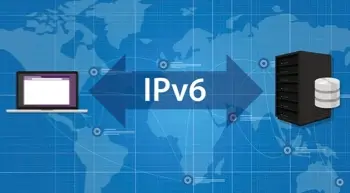What Is IPv6 (Internet Protocol Version 6)?
As the Internet expands, so does the IP address system. The newest version of IP address – IPv6 – is now becoming commonplace for most administrators and users. As it becomes the standard, here’s what you need to know about IPv6, how it’s evolved from the IPv4 address system, and why it’s an improvement.
What is IPv6?
Internet Protocol version 6 (IPv6) is the replacement for IPv4. The Internet has expanded at such a quick rate that IPv4 addresses alone can no longer sustain all the necessary accounts; therefore, IP version 6 allows many more devices to seamlessly connect to the Internet. IPv6 was developed by the Internet Engineering Task Force (IETF) with a more robust architecture, able to satisfy the need for more IP addresses with increased capabilities.
What does an IPv6 address look like?
A version 6 address contains eight groups of four hexadecimal digits with the groups being separated by colons. For example, an IPv6 would be 2600:1005:b062:61e4:74d7:f292:802c:fbfd.
IPv4 addresses look much different. Represented in dot-decimal notation with fewer decimal numbers, they appear like this: 75.123.253.255. Four octets separated by decimals, with each octet ranging from 0 to 255, make up the notation structure. Compare IPv4 to IPv6; you can easily see how IPv6 offers substantially more available addresses.
Understanding the difference between IPv4 and IPv6
There aren’t fundamental differences between IPv4 and IPv6 addresses. However, the updated version of the system has brought about changes – primarily focused on the address size of IP addresses.
IP version 6 has 128 bits of addressing space, which a definite increase compared to IP version 4's 32-bit addressing space. The IPv6 address space has roughly 2128 or (3.4 x 1038) 340,282,366,920,938,463,463,374,607,431,768,211,456 addresses available. To put it more simply, that's 340 trillion trillion trillion addresses.
IPv6 provides enhanced packet header for better routing compared to IPv4. Another big change is the improved mobility it was designed for; network devices on the go will have better support and Internet service. It requires mandatory data security and provides better quality-of-service support overall. These, along with the additional trillions and billions of addresses available, make IP version 6 a definitive upgrade.
Whereas IP version 4 supported broadcast addresses, IP version 6 uses multicast addresses, which clarifies identifiers for a specific set of interfaces that belong to various nodes. It supports both host-inbound and host-outbound multicast traffic.
Types of IPv6 addressing

There are three types of IPv6 addressing: unicast, anycast, and multicast.
- Unicast addressing is one-to-one communication where packets are delivered to a single interface configured with a unique local address.
- Multicast addressing is essentially "one-to-many" communication, where the same packet is sent to a defined group of interfaces on different nodes.
- Anycast addressing is addressing from one device to the nearest device. Routers typically use anycast addressing. A packet goes to an anycast address and the address forwards it to the nearest device based on distance, efficiency, latency, and other factors.
Benefits of IPv6
Again, though the two kinds of IP addresses aren’t intrinsically different, there are benefits to using the up-to-date IPv6 address system. Some of these benefits include:
- Improved multicast routing
- Built-in authentication and privacy measures
- No need for DHCP
- Fewer private IP address conflicts
- No need for network address translation (NAT)
- Auto-configuration
Ultimately, the new version 6 system simplifies the IP address system for all involved – from the user to the administrator.
Frequently asked questions
Should IPv6 be enabled?
If it’s a possibility, yes, we recommend that you enable it. It’s the most up-to-date version of the IP address system, and there are no downsides to enabling it.
Can someone find me with my IPv6 address?
Updating to IP version 6 doesn't put you at any greater risk of being found with your IP address than IPv4 does. If someone does get your IP address, they won't be able to determine your exact physical location either way. An IP address can only narrow down, at best, the town you live in; you'll be protected whether you update or not.
Is IPv6 faster?
Ultimately, no, IPv6 is not faster. IP version 6 is superior in many ways, but users have performed speed tests and determined that though it may be slightly quicker, the difference in speed is marginal. IP version 6 has bigger packet size than IPv4, which slows it down and results in roughly the same Internet speeds as IPv4.
How do I get IPv6 address space?
Most people quality for IPv6 address space. Check with your Internet service providers (ISPs) to be sure, as it depends on how they're rolling out new addresses. Note that not all websites and devices can or will support IP version 6, but that doesn't need to prevent you from updating. Many ISPs can also run dual-stack networks, which means they support IPv4 and IPv6 at the same time for the best functionality possible.
Why don’t I have an IP version 6 yet?
This protocol is slowly replacing IPv4, but it hasn't yet reached everywhere. Again, it will be up to your ISP as to when they start assigning these new addresses to their users. You can always reach out to them to see their plan, or switch ISPs if you aren't happy with the way yours is rolling out IPv6 addresses.